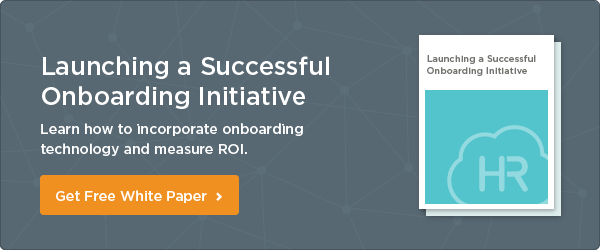How to Treat Onboarding Employees Like Serving Customers



 Cut onboarding time
by 60%—here's the
Ultimate Checklist
that helped do it.
Cut onboarding time
by 60%—here's the
Ultimate Checklist
that helped do it.

When we're selling to customers, we try to determine everything they'll want. After all, if we make the sale, they’ll keep coming back for more. Customer loyalty is huge in a competitive market. Tying down any loose ends and connecting on every level helps your organization achieve success. Looking for the same results with your employees? Striving for a higher level of employee engagement? Deeper level of loyalty? Off the charts creativity?
Serve your employees the way you serve your customers.
1. Everyone is a Customer
Employees are on your front line. They interact with your customers and provide the best possible service. They are your brand ambassadors. They’re building relationships and impacting life decisions. Employees are the extension of your brand.
However, it’s hard for them to sell the brand and project the right messaging, if they aren’t feeling the same positive vibe from the start.
So how do we make everyone a customer?
Talentmgt.com suggests that we start with “consumerized” employee services. Essentially, “a one-stop shop for managing employee needs by coordinating points of contact across the organization to deliver a smooth and consistent experience. Taking the employee-services approach often requires companies to not only rethink the way they interact with employees, but to also reevaluate the structure of the organization and the way they manage workforce-related tasks.”
Think about what your employees need, benefits they'll use, services they'll require, questions they'll have:
• How do they access those services?
• Are they easy to use?
• Can we automate process and avoid lengthy hold times and phone calls?
• Have we incorporated tools and software into one onboarding program?
• Is technology enabled to provide the best user experience?
Understand how to streamline services and anticipate need. This will help you determine how to bundle services in to a “shared services” program or center. For example, allowing employees to access personal information, make updates from a mobile device, and provide time entry and PTO requests, all from a single portal.
2. Purposeful Engagement
Engaging customers is always top priority. From the packaging to the delivery of products and services to the way customer emails and calls are responded to, organizations put tons of thought in to streamlining everything, making it a superior experience at all touch points.
Do the same for your new employees. Make each touchpoint a purposeful point of engagement.
Tweet: Make each touchpoint a purposeful point of engagement. @HRCloud
Let’s take a look at the onboarding process. For example, if new employees will be entering information in to an HRIS platform, make that opportunity count. While they’re entering home address and emergency contacts, provide additional sections where career goals can be written, team organizational charts can be viewed and other important information that your new hire will find valuable. Your organization’s mission and purpose should be clearly branded throughout the process, helping to further engage new employees and help get them started on the right foot.
Don’t be afraid to remove things that just seem to get in the way or bottleneck your onboarding process. If there are too many touch points, too many forms, too many sign-offs needed, consider a revamp. Making things easier, less cumbersome, and more efficient for your employees will increase the engagement level and impact their productivity. You may find that not only does this save time, but it saves the organization money.
A leading professional services firm decided to take this to heart when they determined that their process for sending employees overseas for assignment was extremely time consuming and costly. By analyzing the process and making changes to budget and approval structures, they were able to redefine the entire approach. Talent Management.com shared that the firm was able to “reduce the number of touch points from 140 to 75, eliminating more than 500,000 communications per year. In addition, satisfaction levels for employees rose to 3.8 from 2.6 on a five-point scale, and the number of days needed to staff people across borders dropped to 35 from 60, driving millions of dollars in additional revenue.”
Purposeful engagement = significant savings all around with increasing levels of satisfaction.
3. You’re a Customer, They’re a Customer
As the old management adage states, “You can’t have deeply engaged customers without deeply engaged employees.”
Know this. Each person is an extension of the brand—whether internal or external—they each have an impact on the bottom line. You love your customers and want them to have the very best experience every time. You need your employees to make that happen. They need to believe it; need to live it.
Make it your organization’s mission to treat everyone as a customer and implement the technology tools to make it happen.
Keep Reading
Global Employee Onboarding: Creating a Seamless Experience Across Borders
In today's interconnected business landscape, companies are expanding beyond geographical
The Compliance Catch-Up: What HR Needs to Fix Before Mid-Year Audits
By May, most HR teams have settled into the rhythm of the year. But compliance? That
Secure Onboarding: Best Practices for Protecting Data with Remote Hires
The option of working from home also means that organizations can hire anyone worldwide;
Like What You Hear?
We'd love to chat with you more about how HR Cloud® can support your business's HR needs. Book Your Free Demo

See Workmates in action
Your culture upgrade starts here. Take a quick tour or book a live demo.


Cut onboarding time by 70%
See how growing teams streamline onboarding and save hours for every new hire.

